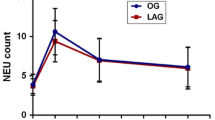Abstract
Background: Major surgery through a laparotomy incision is associated with a postoperative reduction in immune function. Studies in rats involving sham procedures suggest that immune function may be preserved after laparoscopy. This study investigates the effects of incision length and exposure method for bowel resection with respect to postoperative immune function as assessed by delayed-type hypersensitivity (DTH) reactions.
Methods: Male Sprague Dawley rats (n= 175) were challenged preoperatively, immediately postoperatively, and on postoperative day 2 with an intradermal injection of 0.2 mg phytohemagglutinin (PHA), a nonspecific T-cell mitogen. The averages of two measures of perpendicular diameters were used to calculate the area of induration. Anesthesia control rats underwent no procedure. Minilaparotomy rats underwent a 3.5-cm midline incision. Sham full laparotomy rats underwent a 7-cm midline incision. The open bowel-resection group underwent a cecal ligation and resection through a 7-cm midline incision. In the laparoscopic-assisted resection group a CO2 pneumoperitoneum and four-port technique was utilized to deliver the cecum through a 4-mm port where the cecum was extracorporeally ligated and resected.
Results: Preoperative responses were similar in all five groups. Incision length: Full laparotomy group responses were 20% smaller than anesthesia control responses on postoperative day (POD)1 through POD4 (p < 0.02). At no time point were the responses in the minilaparotomy group significantly different from either anesthesia control or full laparotomy group responses. Exposure method: The laparoscopic-assisted resection group responses were 20% larger than open group responses at the time of two of the four postoperative measurements (p < 0.05, both comparisons). At all postoperative time points, open resection group responses were significantly smaller than control responses (p < 0.05, all comparisons), whereas at no time point were laparoscopic group responses significantly different from control responses.
Conclusion: We conclude that postoperative cell-mediated immune function varies inversely with the degree of surgical trauma. Results from the minilaparotomy and laparoscopy groups suggest that procedures done through small incisions may result in preservation of postoperative immune function.
Similar content being viewed by others
Author information
Authors and Affiliations
Additional information
Received: 14 May 1996/Accepted: 16 July 1996
Rights and permissions
About this article
Cite this article
Allendorf, J., Bessler, M., Whelan, R. et al. Postoperative immune function varies inversely with the degree of surgical trauma in a murine model. Surg Endosc 11, 427–430 (1997). https://doi.org/10.1007/s004649900383
Published:
Issue Date:
DOI: https://doi.org/10.1007/s004649900383




